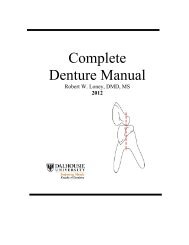RPD Manual 11 - Removable Prosthodontics - Dalhousie University
RPD Manual 11 - Removable Prosthodontics - Dalhousie University
RPD Manual 11 - Removable Prosthodontics - Dalhousie University
You also want an ePaper? Increase the reach of your titles
YUMPU automatically turns print PDFs into web optimized ePapers that Google loves.
Major Connectors - 34<br />
3. Position<br />
- The inferior border should be as low as the lingual frenum and tissue reflections of<br />
the floor of the mouth will permit, as determined by observing functional<br />
movements of the tongue.<br />
- The superior border should be l.5-2.0 mm or more below the free gingival<br />
margin. For hygienic reasons the superior border should still be kept as far from<br />
the gingival margin as possible.<br />
- In distal extension cases there will be some tissue-ward movement of the lingual bar<br />
as the denture base moves during function. If bone loss occurs over the edentulous<br />
ridges, this movement can become more pronounced and this will cause the lingual<br />
bar to impinge upon the lingual tissues. To eliminate the lingual bar from impinging<br />
the soft tissues, a wax spacer (relief) of one thickness of 30 gauge wax is placed<br />
under the major connector when it is being waxed for casting.<br />
Note the anterior portion of the major<br />
connector moves forward as the<br />
posterior portion is loaded and rotates<br />
around the rest. If relief is not<br />
provided, impingement occurs.<br />
B. Lingual Plate (Linguoplate)<br />
The lingual plate consists of a lingual bar plus an<br />
extension over the cingula of anterior teeth. This<br />
mandibular major connector should only be considered in<br />
those rare instances where a lingual bar cannot be used.<br />
Most often, this occurs when there is a high floor of the<br />
mouth, a prominent lingual frenum or lingual tori that<br />
would be impinged upon by a lingual bar, if it was made<br />
with adequate height and distance from the free gingival<br />
margin.<br />
The lingual plate has also been advocated for extensive distal extension cases with severe<br />
vertical resorption of ridges (i.e. little resistance to horizontal rotational tendencies). In these<br />
cases the major connector could provide some additional stability. The lingual plate has been<br />
advocated for use to reduce heavy calculus formation or to stabilize mobile anterior teeth.<br />
However, the plate usually does not reduce mobility, other than stabilizing the teeth during<br />
function. Mobility per se is not a problem unless it is increasing (i.e. pathological process<br />
continuing). Since mobility is often related to periodontal bone loss and since the plate<br />
complicates hygiene by closing the lingual opening of the embrasure spaces, this connector<br />
actually may be contraindicated when mobile teeth are present. When large diastemas are<br />
present, the lingual plate may show through the embrasure spaces.















